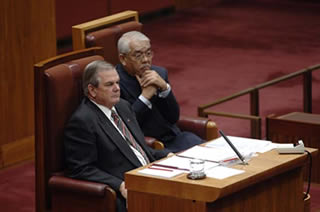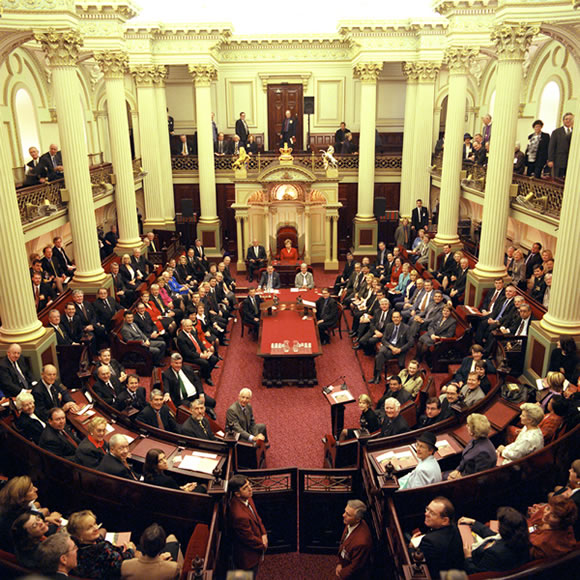174 Distinguished visitors
The President may, by leave of the Senate, admit distinguished visitors to a seat on the floor of the Senate.
Amendment history
Adopted: 19 August 1903 as SO 367 but renumbered as SO 363 for first printed edition
Amended: 2 December 1965, J.427 (to take effect 1 January 1966) (the original first two sentences were deleted as being no longer applicable to the post-Melbourne Senate chamber)
1989 revision: Old SO 377 renumbered as SO 174; terminology modernised by replacing “strangers” with “visitors”
Commentary
Originally called “strangers” after the traditional parliamentary terminology, this chapter contains rules applying to persons other than senators, clerks at the table and officers attending on the Senate. Such persons may not, generally speaking, enter the Senate chamber within the bar area while the Senate is sitting. Formerly, the chapter contained more extensive and prescriptive rules, such as a rule limiting each senator to three guests per day in the galleries, but these rules were pared back by the 1989 revision to those that served the essential purpose of preserving the Senate chamber for working senators and the clerks and officers who support them.

With the concurrence of the Senate, Presiding Officers of other Parliarments are invited to take a seat on the floor of the Senate when visiting Australia (Photo courtesy of AUSPIC)
Although the term “strangers” remained in the standing orders till the 1989 revision, it appears never to have been used in the context of distinguished guests who were always referred to in the Journals as “distinguished visitors”. When the standing order was debated in 1903, President Baker indicated that it was the universal practice in representative Houses to follow the procedures as proposed by the Standing Orders Committee and that the Senate had, in fact, been doing so to date. He informed the Senate that the House of Representatives had adopted identical words. Senator Clemons (FT, Tas) moved an amendment which indicated that he had misunderstood the standing order but he was persuaded to withdraw it when President Baker and others explained the purpose of the rule and when the cantankerous Senator Stewart (ALP, Qld) declared his support for the amendment![1] However, another amendment was agreed to in its place. This was to insert the words “by leave of the Senate” after the word “may” so that the discretion to admit distinguished visitors was removed from the President alone and conferred on the whole Senate. As Senator Clemons indicated, it would be a “greater mark of respect to him [the distinguished visitor] if the whole Senate conferred upon him the right to a seat on the floor of the Chamber”.[2]
An amendment in 1966 removed the original first two sentences:
The President only shall have the privilege of admitting Strangers into that portion of the Chamber below the Bar. Members of the House of Representatives shall have the privilege of admission there without orders.

In its original form, SO 174 had particular reference to the chamber of the Legislative Council of Victoria where the Senate met till 1927 (Photo courtesy of AUSPIC)
These sentences applied to the particular construction of the Legislative Council Chamber at Parliament House, Melbourne, where the Senate sat until 1927 (see Plate 22), and were not applicable either to the chamber occupied by the Senate in Old Parliament House or to the present chamber.[3]
Seating for members of the House of Representatives is now provided on the floor of the chamber behind the bar pursuant to an order of continuing effect agreed to on 18 May 1993.[4]
See Australian Senate Practice, 6th edition, chapter XXIX, for an historical account of “strangers” and Odgers’ Australian Senate Practice, 12th edition, p.139, for current practice.